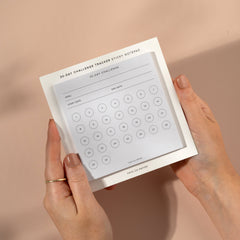Feeling overwhelmed by your daily responsibilities is all too common, especially when juggling work, home, and personal goals. But what if there were a simple, effective way to manage your time, reduce stress, and actually feel accomplished by the end of each day?
In this blog, we’ll walk you through how to plan your day using a daily planner so that you stay focused, feel productive, and avoid burnout.
A daily planner might not seem like much, but it can seriously help you feel more organised and less all over the place.

Why You Feel Overwhelmed
Before diving into planning solutions, it's essential to understand what causes that feeling of overwhelm in the first place. It often stems from:
-
Trying to do too much in too little time
-
Not having a clear priority list
-
Constant multitasking and distractions
-
Lack of boundaries between tasks and rest
-
Unrealistic expectations of productivity
The good news? A well-structured daily planner can help you tackle each of these issues effectively.
Benefits of Using a Daily Planner
A daily planner isn't just for writing down to-do lists. It's a holistic tool that helps you manage your time, energy, and mental well-being. Here’s how it benefits you:
-
Prioritisation: It helps you identify what truly matters each day.
-
Time blocking: You can allocate time to important tasks and breaks.
-
Focus: A clear plan reduces mental clutter and distractions.
-
Tracking progress: You can look back and see your accomplishments.
-
Mindfulness: Taking a few minutes to plan encourages intentional living.
Step-by-Step Guide to Plan Your Day with a Daily Planner
1. Start with a Morning Brain Dump
Before you begin structuring your day, jot down everything that's on your mind, from errands and tasks to meetings and personal reminders. Getting everything out of your head and onto paper clears mental space and reduces anxiety.
Use the notes section in your daily planner to do this each morning. This can take just 5 minutes and is a crucial step toward feeling more organized.
2. Identify Your Top 3 Priorities
Out of everything you’ve written down, pick the three most important tasks for the day. These are the non-negotiables that must get done.
Label them clearly in your daily planner, and make sure you schedule them when your energy levels are highest, usually in the morning or right after a break.

3. Time Block Your Day
Divide your day into blocks of time, assigning specific activities to each block. This method helps eliminate procrastination and keeps you on track.
For example:
-
9:00 AM – 10:30 AM: Work on project report
-
10:30 AM – 10:45 AM: Break
-
10:45 AM – 12:00 PM: Respond to emails
-
1:00 PM – 2:00 PM: Client calls
Most daily planners include time slots for each hour, making this process easy to follow.
4. Schedule Breaks and Buffer Time
A common mistake people make is overfilling their schedules. To avoid burnout, include short breaks and buffer time between tasks.
Use your daily planner to block out 10–15 minute breaks every 90 minutes of work. It boosts productivity and keeps your mind fresh.
5. Reflect and Reset in the Evening
Use the end of your day to reflect: What did you accomplish? What didn’t go as planned? What will you carry over to tomorrow?
Many well-designed daily planners include a space for reflection or gratitude journaling, use it to gain perspective and celebrate small wins.
Common Planning Mistakes (and How to Avoid Them)
Even the best intentions can go awry. Watch out for these common mistakes:
-
Overloading your day: Stick to 3–5 key tasks daily.
-
Skipping planning time: Schedule 10 minutes each morning to plan.
-
Not being flexible: Leave space for unexpected changes.
-
Comparing your schedule to others: Your planner should reflect your goals.
Tools to Complement Your Daily Planner
While a physical daily planner is powerful on its own, you can also pair it with digital tools for reminders or longer-term planning:
-
Google Calendar – for syncing meetings and events
-
Notion or Evernote – for project and idea management
-
Pomofocus – a simple timer based on the Pomodoro technique (visit pomofocus.io to try it)
These tools work beautifully alongside your paper planner to help you stay focused and in control.
A daily planner is more than just a scheduling tool. It’s a daily companion that helps you stay grounded, focused, and aligned with your goals. With a little planning each day, you’ll find that your productivity improves, your stress decreases, and your sense of control grows. Remember, it’s not about perfection; it’s about progress. Start small, stay consistent, and let your daily planner guide you toward a more balanced and fulfilling life.
Looking to get started with the perfect daily planner? Explore our bestsellers to find one that brings calm and clarity to your everyday life.



Leave a comment